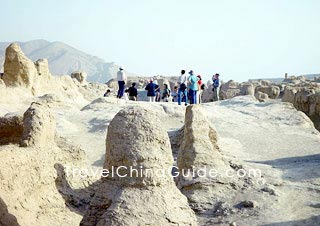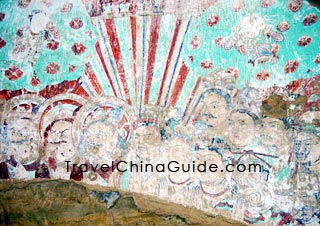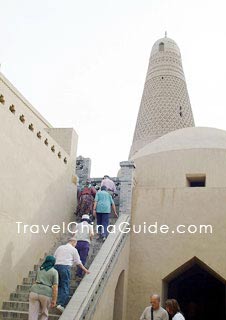Turpan History & Culture
 |
| Ancient City of Jiaohe built from 2nd to 5th Century by Cheshi Kingdom |
Aboriginals in Turpan are called the Gushi people and this place was known as Gushi in the distant past. The city is situated on the ancient course of the Silk Road, a hub of economic and cultural accumulations to West Asia and West Europe. This region embodies the convergence of Eastern and Western culture as well as many religions. It also has the richest relics along the Silk Road, including some 200 ancient city sites, grotto temples, beacon sites, tombs and rock paintings. Reportedly, above eighty percent of the cultural relics in Xinjiang Museum were excavated in Turpan.
 |
| Bezeklik Thousand Buddha Caves in the State of Gaochang (499-640) |
During the Han Dynasty (206BC-220AD), Turpan was the capital of Cheshiqian Kingdom, one of the thirty-six kingdoms in Xi Yu (literally the Western Regions, referring to most parts of Xinjiang and part of Central Asia) and subjected to the Han Court. The Ancient City of Jiaohe in the western part of the city was the royal city of the kingdom, the only city in the world to be constructed from raw earth. The kingdom perished in Northern Wei (386-584) around the year of 450 and another kingdom, called Gaochang, was established ten years later. It was then that the people of Turpan entered a period which was dominated by the Han Culture.
Gaochang declined in the early Tang Dynasty (618-907) and Xizhou prefecture was set up with the same basic jurisdiction as present-day Turpan. In the same year, the Tang Court set up the Anxi Protectorate to pacify the Western Regions. Around 709, the Tubo and Uighur (an ancient name of today's Uygur) tribes competed with each other for ownership of Xizhou and eventually the Uighurs won. They established the Gaochang Uighur Kingdom centered in Gaochang City. During the late Yuan Dynasty (1279-1368), this area was made up of Liucheng, Huozhou and Turpan. This was the first time the name Turpan appeared.
 |
| Emin Minaret of Qing Dynasty |
Turpan is one of the two centers of Uygur culture and was the earliest residence of the Uighurs (ancestors of the Uygurs) when they first moved here in the 9th Century. Local religion, rites and architecture are all steeped in Uygur history. Turpan was once the Buddhist center of the Silk Road. The famous monk Xuan Zang of Tang passed through this place during his journey to the west and the pulpit where he preached is still among the ruins of the Ancient City of Gaochang. The Bezeklik Thousand Buddha Caves was also a Buddhist shrine during the Gaocheng period. The caves feature mural paintings from the Tang through to the Yuan Dynasty, which are enduring artistic treasures of the Uighurs. Music and dance were, and still are, very important arts to the local people. The Gaochang style of music and dancing was very popular in China during the Tang Dynasty.
A German scholar once said that nowhere else on the Silk Road has such a colorful and rich culture thoroughly blended with multifold religions and ethnic groups.
- Last updated on Jul. 18, 2022 -